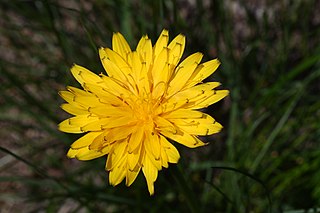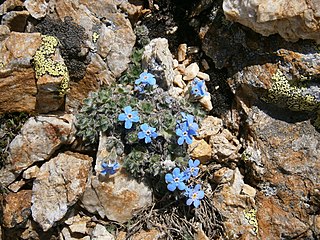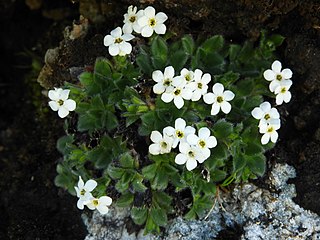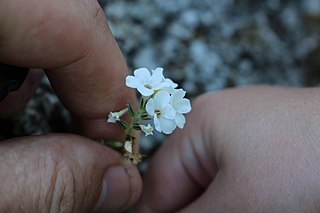
Boraginaceae, the borage or forget-me-notfamily, includes about 2,000 species of shrubs, trees, and herbs in 146 to 156 genera with a worldwide distribution.

Myosotis is a genus of flowering plants in the family Boraginaceae. The name comes from the Ancient Greek μυοσωτίς "mouse's ear", which the foliage is thought to resemble. In the Northern Hemisphere, they are colloquially known as forget-me-nots or scorpion grasses. Myosotis alpestris is the official flower of Alaska and Dalsland, Sweden. Plants of the genus are not to be confused with Chatham Islands' forget-me-nots, which belong to the related genus Myosotidium.

Myosotis laxa is a species of forget-me-not known by several common names, including tufted forget-me-not, bay forget-me-not, small-flower forget-me-not, and small-flowered forget-me-not. It has a circumboreal distribution, occurring throughout some parts of the Northern Hemisphere. It grows in many types of habitat, including moist and wet areas; it is sometimes aquatic, growing in shallow water.

Myosotis scorpioides, the true forget-me-not or water forget-me-not, is a herbaceous perennial flowering plant in the borage family, Boraginaceae.

Myosotis stricta is a plant species of the genus Myosotis. Common names include strict forget-me-not and blue scorpion grass.
Forget-me-not refers to any member of the flowering plant genus Myosotis, particularly:
NVC community CG10 is one of the calcicolous grassland communities in the British National Vegetation Classification system. Of the upland group of calcicolous grasslands, it is the only one with a short sward associated with heavy grazing.

The Giardino Botanico Alpinia is a botanical garden specializing in alpine plants, located at 800 m altitude above Stresa on Lake Maggiore, Province of Verbano-Cusio-Ossola, Piedmont, Italy. It can be reached via the Lido di Carciano - Alpino - Mottarone cable car, and is open daily in the warmer months.

Nothocalais alpestris is a species of flowering plant in the family Asteraceae known by the common name alpine lake false dandelion. It is native to the Cascade Range, Sierra Nevada and other mountains from northern Washington to central California, where it grows in subalpine forests and meadows, most commonly at 1,200–2,700 m (4,000–9,000 ft) elevation.

Grays Peak National Recreation Trail or Grays Peak Trail lies along the Continental Divide of the Americas, part of the Rocky Mountains in the U.S. state of Colorado. It is located in the White River National Forest, Summit County. Grays Peak Trail is south of Interstate 70, east of Keystone Resort and near Montezuma. Grays Peak is adjacent to Torreys Peak. The Grays Peak Trail begins 3 miles above Interstate 70, at 11,200 feet. The summit of Grays Peak is 3.7 miles from the trailhead. Torreys Peak is 4.15 miles from the trailhead, across a saddle from Grays Peak. Grays Peak Trail ascends south through the wetland willows of Stevens Gulch. The trail passes between Stevens Mine on a lower slope of McClellan Mountain, 13,587 feet, forming the eastern wall of the valley, and Sterling Silver Group Mine beside the trail to the right on Kelso Mountain, 13,164 feet. The trail climbs 900 feet during the first 1.7 miles to a National Recreation Trail sign indicating that the summit is two miles farther.
Myosotis azorica, common name Azorean mouse-ear or Azorean forget-me-not, is a plant species endemic to the Azores Islands in the North Atlantic Ocean.

Alpine forget-me-not is a common name for several plants in the Boraginaceae (forget-me-not) family and may refer to:

Hedypnois rhagadioloides, the Cretanweed or scaly hawkbit, is a species of plant in the tribe Cichorieae within the family Asteraceae. It is native to the Mediterranean Region and neighboring areas from Canary Islands to Iran, and naturalized in Australia and in parts of the Americas.

Carlos Adolfo Lehnebach is a New Zealand botanist. He is employed as a botany curator at the Museum of New Zealand Te Papa Tongarewa. Lehnebach has a master's degree and a PhD from Massey University.

Myosotis macrosperma, commonly called largeseed forget-me-not, is a species of flowering plant in the borage family (Boraginaceae). It is native to North America, where it found in the eastern United States and Ontario, Canada. It is found in a wide variety of natural habitats, including areas of bottomland forests, mesic forests, and prairies. It appears to be associated with nutrient rich soils. It is tolerant of disturbance, and can be found in highly degraded communities such as pastures and fallow fields.

Myosotis secunda, also known as the creeping forget-me-not is a species of flowering plant from the family Boraginaceae.

Myosotis retrorsa is a species of flowering plant in the family Boraginaceae, endemic to the South Island of New Zealand. Heidi Meudt, Jessica Prebble and Rowan Hindmarsh-Walls described the species. Plants of this species of forget-me-not are perennial with a prostrate habit, bracteate inflorescences, and white corollas.

Myosotis brevis is a species of flowering plant in the family Boraginaceae, endemic to New Zealand. George Simpson and J.S. Thomson described M. pygmaea var. minutiflora in 1942, and Peter de Lange and John Barkla recognized it at species rank in 2010, as M. brevis. Plants of this species of forget-me-not are small and annual, with a prostrate habit, bracteate inflorescences, tiny white corollas, and brown or green leaves.

Myosotis lytteltonensis is a species of flowering plant in the family Boraginaceae and a synonym of Myosotis australis. It was first described as a variety of M. australis, considered endemic to the South Island of New Zealand, then raised to species status, and subsequently synonymised with Myosotis australis in 2020. Plants of this species of forget-me-not are perennial rosettes with ebracteate inflorescences and white or yellow corollas with stamens that are fully included in the corolla tube or sometimes partly exserted.

Myosotis oreophila is a species of flowering plant in the family Boraginaceae, endemic to the South Island of New Zealand. Donald Petrie described the species in 1896. Plants of this species of forget-me-not are perennial rosettes with ebracteate inflorescences and white corollas with stamens that are partially exserted.

















